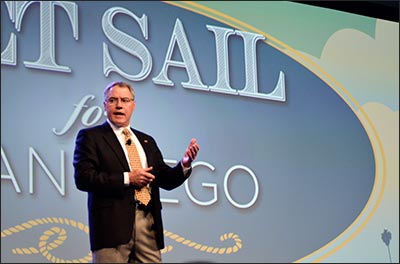CattleFax Outlook Presented
CattleFax predicts market shock is nearly over, turbulence still ahead.
SAN DIEGO, Calif. (Jan. 28, 2016) — Recent price shock in the market and insights about the turbulence ahead were explained today to more than 2,000 beef producers at the CattleFax Outlook Session convened during the 2016 Cattle Industry Convention and NCBA Trade Show.

Randy Blach explained how tight global protein supplies and a strong export market in 2014 and 2015 led to the ‘perfect storm’ of market peaks and significant drops seen in recent extremes.
The downward spiral in price from record-high cattle prices has been a rough ride for many in the business, but CattleFax CEO Randy Blach said the market correction has mostly occurred. He explained how tight global protein supplies and a strong export market in 2014 and 2015 led to the ‘perfect storm’ of market peaks and significant drops seen in recent extremes. Animal health challenges in both poultry and pork production led to tight supplies in 2014, which saw the tightest per capita protein supply in the last 20 years.
“We are coming off of historic peaks in the cattle market, created by unique conditions in the global beef and protein markets,” said Blach. “Dynamics, specifically global beef supply, led to a large correction in price. That big market downward swing is nearly over now. However, the cycle shows prices continuing to trend lower in 2016, 2017 and 2018.”
Analysts predicted the cattle feeder will lose about $200 per head, stocker operators with tight margins, and cow-calf with profitable margins. The team of economists expect fed-cattle prices averaging $130-$145 during the next year.

“The cow-calf margins will still be profitable, but substantially lower than in the past two years,” said Kevin Good, senior analyst and fed-cattle market specialist, CattleFax.
“The cow-calf margins will still be profitable, but substantially lower than in the past two years,” said Kevin Good, senior analyst and fed-cattle market specialist, CattleFax. “We predict the cattle feeder will have tight margins for the year overall with potential for profit mid-year.”
A two-year El Niño weather pattern has replenished moisture conditions across the country, specifically the West Coast, which saw some relief in 2015. The weather outlook appears favorable, especially moisture conditions for grasslands, according to the weather outlook from Art Douglas, professor emeritus at Creighton University.
“As we head into 2016, a split jet stream pattern will favor above-normal precipitation from California to the Southern Plains and the Southeast through March,” said Douglas. “In the Corn Belt, spring will be wetter-than-normal, which will be accompanied by slower spring warming. Delays in fieldwork and planting dates are likely to result.”

Art Douglas discussed CattleFax weather predictions for 2016
Analysts predicted $294 added value per head in exports for the year ahead, a $66 drop per head from 2014 values. This decrease in export potential is caused by a combination of a strong U.S. dollar, slowdown in global market and challenges with market access. Russia and China are still the biggest opportunities for U.S. beef but trade restrictions will continue to limit potential in the year ahead.
Imports of beef are predicted to be down 8% since domestic cow kill will increase. In recent years the United States was in a rebuilding stage and females were held back for the cow herd. Imports of slaughter cows from Australia were available because of drought, but improving moisture conditions in 2016 will keep females in Australia for herd rebuilding. Analysts predict the growth in the U.S. cow herd will slow in the coming year and predict a 600,000-head cow herd increase, which is down from a 1.1 million increase in 2015.
Editor’s Note: This article was provided as a news release by the National Cattlemen's Beef Association. For more information, visit the company website at www.cattlefax.com.

